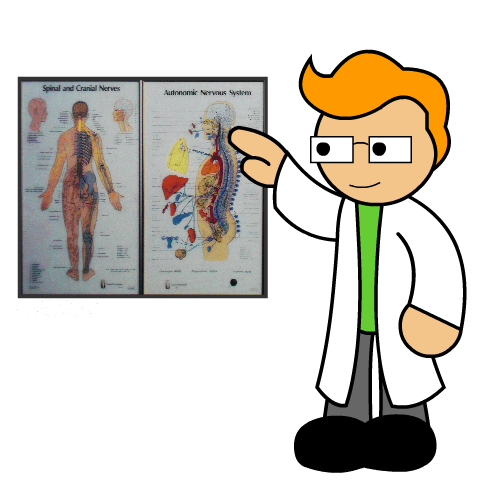Even in Patient Education,
Size Matters – So …
How Big Do You Want It?
Chiropractors have a powerful story to tell.
To reach most deeply into someone’s understanding,
‘telling’ just isn’t enough. That’s why Docs use nerve charts.
In 1976, I envisioned a modern electrification of the same
Nerve Anatomy Charts Chiropractors already had on their walls.
The result …
a patient could just
walk up to this slick picture,
poke a button,
And…
LIGHTS . . . slammed home the consequences of the subluxation.
The Neuropatholator grew in 1979 to 3 electrically synchronized charts.
Four and a half feet of wall space dedicated to instant understanding.
It was dramatic,
It was powerful,
and
It built thousands of practices … at the push of a button.
Chiropractors would tell me that
as they explained the problem during the ROF,
they would touch their patient’s problem area, and
press the button on the Neuropatholator.
Some patients would actually buckle at the knees a little.
The impact is immediate and indelibly memorable.
There was still more to show and tell though, so in ’84
we created 60 mix and match posters
and bound them into the very portable SHO chart
to take the message to larger audiences,
screenings and even daily topics.
The result was even greater referrals
while leveraging time wisely.
But still not satisfied, I thought,
“What if the Neuropatholator could push its own buttons?”
And even use a small LED sign to silently narrate the activity on the chart?
That meant it could be in the Reception Area
and draw people into an enhanced Chiropractic awareness.
It could even show the direction of nerve transmission,
both afferent and efferent.
The computerized Neuropatholator Mini 3 was a huge success when
it debuted at The Las Vegas Parker Seminar in January 1991.
The next challenge … How could we make it as big as your wall?
2001 brought us computers and projectors.
Everybody loves reaching out and touching the picture though –
so in addition to a mouse or trackpad,
BAM … the Neuropatholator Touch Software was optimized for touchscreen in 2002.
So now we have
bigger computer screens,
interactivity and animation,
added to that, are all the SHO posters, posture, subluxation,
degeneration, 3D spinal images and videos, and so much more.
And best of all we’ve still got fingertip activation.
There was only one frontier left. Our patients’ pockets and the palm of their hands.
Since long before the first Newton by Apple,
or the Palm Pilot Personal Assistant which all gave way to the iPhone,
I envisioned a Neuropatholator that could be carried from room to room.
After all, in the 80’s DCs used folders, clipboards and travel cards.
My idea was an electronic clipboard Neuropatholator.
We had one working prototype. However,
Technology in the 80’s was inadequate and very expensive,
Microsoft didn’t even create Windows for 4 more years.
Today though, we have tablets and phones by the billions to
help put your message under your patient’s thumb,
any time of the day.
The Neuropatholator in your private mobile App brings
amazing ‘Speed of Sight Patient Inspiration’ throughout your community,
puts you under their thumb and
in their face which
helps ‘put more patients on your tables’.
From phone and tablet to laptops,
to touchscreens and 70” TVs,

Visual Odyssey and the Neuropatholator give you the best of all worlds!!!
What type of Neuropatholator will be best for you?
As you can see, biggest isn’t always best. That’s why we have all sizes!
How motivated do you want your patients and community to be?
Call Now to set a time so we can discuss how to
super-charge your practice with
exactly what you want and need.
Call for a personal demonstration today.
770-646-8031 / 800-541-4449
From Wall to Computer to Mobile Device
You will educate and inspire
your patients
and your community
‘at the Speed of Sight!’









